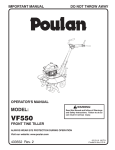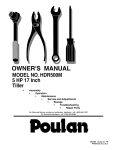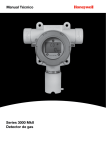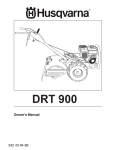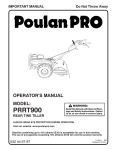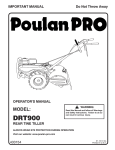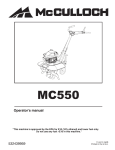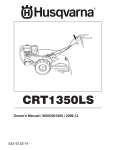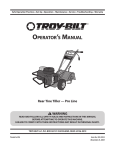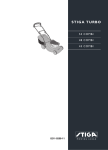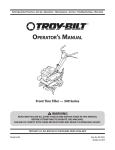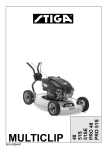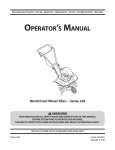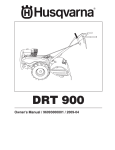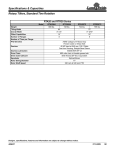Download Poulan VF550 User's Manual
Transcript
IMPORTANT MANUAL DO NOT THROW AWAY OPERATOR'S MANUAL MODEL: VF550 WARNING: Read this Manual and follow all Warnings and Safety Instructions. Failure to do so can result in serious injury. FRONT TINE TILLER ALWAYS WEAR EYE PROTECTION DURING OPERATION Visit our website: www.poulan.com 433552 Rev. 2 02.23.10 AP/TH Printed in the U.S.A. SAFETY RULES Safe Operation Practices for Walk-Behind Powered Rotary Tillers TRAINING • • • • • Read the Owner’s Manual carefully. Be thoroughly familiar with the controls and the proper use of the equipment. Know how to stop the unit and disengage the controls quickly. Never allow children to operate the equipment. Never allow adults to operate the equipment without proper instruction. Keep the area of operation clear of all persons, particularly small children, and pets. • • • • • PREPARATION • • • • • • • • • • Thoroughly inspect the area where the equipment is to be used and remove all foreign objects. Disengage all clutches and shift into neutral before starting the engine (motor). Do not operate the equipment without wearing adequate outer garments. Wear footwear that will improve footing on slippery surfaces. Handle fuel with care; it is highly flammable. Use an approved fuel container. Never add fuel to a running engine or hot engine. Fill fuel tank outdoors with extreme care. Never fill fuel tank indoors. Replace gasoline cap securely and clean up spilled fuel before restarting. Use extension cords and receptacles as specified by the manufacturer for all units with electric drive motors or electric starting motors. Never attempt to make any adjustments while the engine (motor) is running (except where specifically recommended by manufacturer). MAINTENANCE AND STORAGE • • • • • • • • • • • • Keep machine, attachments, and accessories in safe working condition. Check shear pins, engine mounting bolts, and other bolts at frequent intervals for proper tightness to ensure the equipment is in safe working condition. Never store the machine with fuel in the fuel tank inside a building where ignition sources are present, such as hot water and space heaters, clothes dryers, and the like. Allow the engine to cool before storing in any enclosure. Always refer to the operator’s guide instructions for important details if the tiller is to be stored for an extended period. - IMPORTANT CAUTIONS, IMPORTANTS, AND NOTES ARE A MEANS OF ATTRACTING ATTENTION TO IMPORTANT OR CRITICAL INFORMATION IN THIS MANUAL. IMPORTANT: USED TO ALERT YOU THAT THERE IS A POSSIBILITY OF DAMAGING THIS EQUIPMENT. OPERATION • • Keep children and pets away. Do not overload the machine capacity by attempting to till too deep at too fast a rate. Never operate the machine at high speeds on slippery surfaces. Look behind and use care when backing. Never allow bystanders near the unit. Use only attachments and accessories approved by the manufacturer of the tiller. Never operate the tiller without good visibility or light. Be careful when tilling in hard ground. The tines may catch in the ground and propel the tiller forward. If this occurs, let go of the handlebars and do not restrain the machine. Do not put hands or feet near or under rotating parts. Exercise extreme caution when operating on or crossing gravel drives, walks, or roads. Stay alert for hidden hazards or traffic. Do not carry passengers. After striking a foreign object, stop the engine (motor), remove the wire from the spark plug, thoroughly inspect the tiller for any damage, and repair the damage before restarting and operating the tiller. Exercise caution to avoid slipping or falling. If the unit should start to vibrate abnormally, stop the engine (motor) and check immediately for the cause. Vibration is generally a warning of trouble. Stop the engine (motor) when leaving the operating position. Take all possible precautions when leaving the machine unattended. Disengage the tines, shift into neutral, and stop the engine. Before cleaning, repairing, or inspecting, shut off the engine and make certain all moving parts have stopped. Disconnect the spark plug wire, and keep the wire away from the plug to prevent accidental starting. Disconnect the cord on electric motors. Do not run the engine indoors; exhaust fumes are dangerous. Never operate the tiller without proper guards, plates, or other safety protective devices in place. NOTE: Gives essential information that will aid you to better understand, incorporate, or execute a particular set of instructions. Look for this symbol to point out important safety precautions. It means CAUTION!!! BECOME ALERT!!! YOUR SAFETY IS INVOLVED. CAUTION: Always disconnect spark plug wire and place wire where it cannot contact spark plug in order to prevent accidental starting when setting up, transporting, adjusting or making repairs. WARNING The engine exhaust from this product contains chemicals known to the State of California to cause cancer, birth defects, or other reproductive harm. 2 PRODUCT SPECIFICATIONS CUSTOMER RESPONSIBILITIES • • Read and observe the safety rules. Follow a regular schedule in maintaining, caring for and using your tiller. Follow instructions under “Maintenance” and “Storage” sections of this Manual. Gasoline Capacity: 0.9 Quarts (0,85 L) Unleaded Regular Oil (API-SG-SL): (Capacity: 20 oz./0.6L) SAE 10w-30(Above 32°F/0°C) SAE 5w-30(Below 32°F/0°C) • Spark Plug: (Gap: .030"/0.76mm) Champion RJ19LM or J19LM IMPORTANT: THIS UNIT IS EQUIPPED WITH AN INTERNAL COMBUSTION ENGINE AND SHOULD NOT BE USED ON OR NEAR ANY UNIMPROVED FOREST-COVERED, BRUSHCOVERED OR GRASS COVERED LAND UNLESS THE ENGINE'S EXHAUST SYSTEM IS EQUIPPED WITH A SPARK ARRESTER MEETING APPLICABLE LOCAL LAWS (IF ANY). IF A SPARK ARRESTER IS USED, IT SHOULD BE MAINTAINED IN EFFECTIVE WORKING ORDER BY THE OPERATOR. IN THE STATE OF CALIFORNIA, A SPARK ARRESTER IS REQUIRED BY LAW (SECTION 4442 OF THE CALIFORNIA PUBLIC RESOURCES CODE). OTHER STATES MAY HAVE SIMILAR LAWS. FEDERAL LAWS APPLY ON FEDERAL LANDS. SEE YOUR AUTHORIZED SERVICE CENTER/DEPARTMENT FOR SPARK ARRESTER. CONGRATULATIONS on your purchase of a new tiller. It has been designed, engineered and manufactured to give you the best possible dependability and performance. Should you experience any problems you cannot easily remedy, please contact your nearest authorized service center. We have competent, well-trained technicians and the proper tools to service or repair this unit. Please read and retain this manual. The instructions will enable you to assemble and maintain your tiller properly. Always observe the “SAFETY RULES”. TABLE OF CONTENTS MAINTENANCE ..................................................... 10-12 SERVICE & ADJUSTMENTS ................................. 13-14 STORAGE .................................................................... 15 TROUBLESHOOTING ................................................. 16 PARTS..................................................................... 17-21 SAFETY RULES ............................................................ 2 PRODUCT SPECIFICATIONS ....................................... 3 CUSTOMER RESPONSIBILITIES................................. 3 ASSEMBLY ................................................................. 4-5 OPERATION ............................................................... 6-9 MAINTENANCE SCHEDULE ...................................... 10 3 ASSEMBLY Your new tiller has been assembled at the factory with exception of those parts left unassembled for shipping purposes. To ensure safe and proper operation of your tiller all parts and hardware you assemble must be tightened securely. Use the correct tools as necessary ensure proper tightness. TOOLS REQUIRED FOR ASSEMBLY UNPACK CARTON & INSTALL HANDLE (See Fig. 2 and 3) A socket wrench set will make assembly easier. Standard wrench sizes are listed. (1) Utility Knife CAUTION: Be careful of exposed staples when handling or disposing of carton material. OPERATOR’S POSITION (See Fig. 1) IMPORTANT: WHEN UNPACKING AND ASSEMBLING TILLER, BE CAREFUL NOT TO STRETCH OR KINK CABLE(S). When right or left hand is mentioned in this manual, it means when you are in the operating position (standing behind tiller handles). • • • • FRONT • LEFT Cut cable ties securing handle column. Remove all packing from carton. Remove lower handle column from carton. Position lower handle column between bent tubes, lining up holes as shown. Secure lower handle column using two (2) 4-1/2" carriage bolts, two (2) washers and two (2) handle knobs. Tighten securely. LOWER HANDLE COLUMN RIGHT KNOBS WASHERS OPERATOR'S POSITION BENT TUBES BOLTS Fig. 1 • • CONTENTS OF HARDWARE PACK • • • (1) Washer (3) Handle Knobs Fig. 2 Remove upper handle column from carton. Route cable(s) as shown and slide upper handle column onto lower handle column. Secure upper handle column using two (2) 2-1/2" carriage bolts and two (2) handle knobs. Tighten securely. Cut away carton. Cut cable ties securing tiller to skid. Remove tiller from skid by pulling backwards. Manual UPPER HANDLE COLUMN (1) Carriage Bolt 5/16”-18 unc x 4-1/2” (1) Clevis Pin TINE CONTROL CABLE (2) Carriage Bolts 5/16”-18 unc x 2-1/2” (1) Hairpin Clip BOLTS KNOBS Fig. 3 4 ASSEMBLY TO INSTALL DEPTH STAKE (See Fig. 4) • • • Remove screw(s) securing depth stake to skid and discard the screw(s). Slide depth stake down into transport arm track, lining up a hole in the depth stake with hole in transport arm. Install clevis pin and hairpin clip. DEPTH STAKE CLEVIS PIN HAIRPIN CLIP Fig. 4 TILLING WIDTH • Tilling width may be adjusted to better handle your tilling conditions (See “TINE ARRANGEMENT” in the Service and Adjustments section of this manual.) TINE OPERATION • Check tine operation before first use. (See “TINE OPERATION CHECK” in the Service and Adjustments section of this manual.) 5 OPERATION KNOW YOUR TILLER READ THIS MANUAL AND SAFETY RULES BEFORE OPERATING YOUR TILLER. Compare the illustrations with your tiller to familiarize yourself with the location of various controls and adjustments. Save this manual for future reference. These symbols may appear on your Tiller or in literature supplied with the product. Learn and understand their meaning. FORWARD TINE CONTROL PRIMER RECOIL STARTER HANDLE THROTTLE CONTROL DEPTH STAKE Fig. 5 MEETS ANSI SAFETY REQUIREMENTS Our tillers conform to the safety standards of the American National Standards Institute. DEPTH STAKE - Controls forward speed and the depth at which the tiller will dig. FORWARD TINE CONTROL - Engages tines in forward direction. RECOIL STARTER HANDLE - Used to start the engine. direction. THROTTLE CONTROL - Controls engine speed. PRIMER - pumps additional fuel from the carburetor to the cylinder for use when starting a cold engine. 6 OPERATION The operation of any tiller can result in foreign objects thrown into the eyes, which can result in severe eye damage. Always wear safety glasses or eye shields before starting your tiller and while tilling. We recommend a wide vision safety mask for over spectacles or standard safety glasses. 00155 HOW TO USE YOUR TILLER TILLING The speed and depth of tilling is regulated by the position of the depth stake. The depth stake should always be below the wheels for digging. It serves as a brake to slow the tiller’s forward motion to enable the tines to penetrate the ground. Also, the more the depth stake is lowered into the ground the deeper the tines will dig. Know how to operate all controls before adding fuel and oil or attempting to start engine. STOPPING (See Fig. 6) TINES 1. Release tine control to stop movement. ENGINE 2. Move throttle control to "STOP" position. DEPTH STAKE (See Fig. 7) Adjust depth stake by removing the hairpin clip and clevis pin. Change depth stake to desired position. Replace the clevis pin and hairpin clip. • For normal tilling, set depth stake at the second or third hole from the top. TINE CONTROL “OFF” (UP) POSITION TINE CONTROL “ON” (DOWN) POSITION DEPTH STAKE HAIRPIN CLIP THROTTLE CONTROL CLEVIS PIN Fig. 7 TO TRANSPORT CAUTION: Before lifting or transporting, allow tiller engine and muffler to cool. Disconnect spark plug wire. Drain gasoline from fuel tank. AROUND THE YARD • Adjust depth stake so clevis pin is in bottom hole. • Push tiller handles down, raising tines off the ground. • Push or pull tiller to desired location. Fig. 6 TINE OPERATION (See Fig. 6) • Squeeze tine control to handle. AROUND TOWN • Disconnect spark plug wire. • Drain fuel tank. • Transport in upright position to prevent oil leakage. 7 OPERATION BEFORE STARTING ENGINE IMPORTANT: WHEN OPERATING IN TEMPERATURES BELOW 32°F(0°C), USE FRESH, CLEAN WINTER GRADE GASOLINE TO HELP ENSURE GOOD COLD WEATHER STARTING. IMPORTANT: BE VERY CAREFUL NOT TO ALLOW DIRT TO ENTER THE ENGINE WHEN CHECKING OR ADDING OIL OR FUEL. USE CLEAN OIL AND FUEL AND STORE IN APPROVED, CLEAN, COVERED CONTAINERS. USE CLEAN FILL FUNNELS. CAUTION: Alcohol blended fuels (called gasohol or using ethanol or methanol) can attract moisture which leads to separation and formation of acids during storage. Acidic gas can damage the fuel system of an engine while in storage. To avoid engine problems, the fuel system should be emptied before storage of 30 days or longer. Drain the gas tank, start the engine and let it run until the fuel lines and carburetor are empty. Use fresh fuel next season. See Storage Instructions for additional information. Never use engine or carburetor cleaner products in the fuel tank or permanent damage may occur. CHECK ENGINE OIL LEVEL (See Fig. 8) 1. Remove hangtag from engine. 2. The engine in your unit has been shipped, from the factory, already filled with SAE 30 summer weight oil. 3. With engine level, remove engine oil filler plug. 4. Engine oil should be at "FULL" line on dipstick. If low, fill to "FULL" line. For approximate capacity, see "PRODUCT SPECIFICATIONS" on page 3 of this manual. 5. Reinstall engine oil filler plug. 6. Check oil before each use. Add oil if needed. TO START ENGINE (See Fig. 9) CAUTION: DO NOT overfill engine with oil, or it will smoke heavily from the muffler on startup. • • CAUTION: KEEP TINE CONTROL IN “OFF” POSITION WHEN STARTING ENGINE. For cold weather operation you should change oil for easier starting (See “OIL VISCOSITY CHART” in the Maintenance section of this manual). To change engine oil, see the Maintenance section of this manual. NOTE: Due to protective coatings on the engine, a small amount of smoke may be present during the initial use of the product and should be considered normal. 1. Make sure spark plug wire is properly connected. 3. Place throttle control in “FAST” position. 4. To start a cold engine, push primer three (3) times before trying to start. Use a firm push. This step is not usually necessary when starting an engine which has already run for a few minutes. 5. Grasp recoil starter handle with one hand and grasp tiller handle with other hand. Pull recoil starter handle quickly. Do not let starter rope snap back. NOTE: In cooler weather it may be necessary to repeat priming steps. In warmer weather over priming may cause flooding and engine will not start. If you do flood engine, wait a few minutes before attempting to start and do not repeat priming steps. OIL FILLER CAP MAXIMUM UPPER LEVEL MINIMUM UPPER LEVEL RECOIL STARTER HANDLE Fig. 8 THROTTLE CONTROL ADD GASOLINE • Fill fuel tank to bottom of filler neck. Do not overfill. Use fresh, clean, regular unleaded gasoline with a minimum of 87 octane. (Use of leaded gasoline will increase carbon and lead oxide deposits and reduce valve life). Do not mix oil with gasoline. Purchase fuel in quantities that can be used within 30 days to assure fuel freshness. CAUTION: Do not fill above 1/2 inch of top of fuel tank to prevent spills and to allow for fuel expansion. If gasoline is accidentally spilled, move machine away from area of spill. Avoid creating any source of ignition until gasoline vapors have disappeared. Wipe off any spilled oil or fuel. Do not store, spill or use gasoline near an open flame. PRIMER SPARK PLUG Fig. 9 8 OPERATION BREAKING IN YOUR TILLER Break-in your belt(s), pulleys and tine control before you actually begin tilling. • Start engine, tip tines off ground by pressing handles down and engage tine control to start tine rotation. Allow tines to rotate for five minutes. TILLING HINTS 3 4 CAUTION: Until you are accustomed to handling your tiller, start actual field use with throttle in slow position. 5 To help tiller move forward, lift up the handles slightly (thus lifting depth stake out of ground). To slow down the tiller, press down on handles. If you are straining or tiller is shaking, the depth stake is not set properly in the soil being tilled. The proper setting of the depth stake is through trial and error and depends upon the soil condition. (The harder or wetter the ground, the slower the engine and tine speed needed. Under these poor conditions, at fast speed the tiller will run and jump over the ground). A properly adjusted tiller will dig with little effort from the operator. • Tilling is digging into, turning over, and breaking up packed soil before planting. Loose, unpacked soil helps root growth. Best tilling depth is 4"-6". A tiller will also clear the soil of unwanted vegetation. The decomposition of this vegetable matter enriches the soil. Depending on the climate (rainfall and wind), it may be advisable to till the soil at the end of the growing season to further condition the soil. • Soil conditions are important for proper tilling. Tines will not readily penetrate dry, hard soil which may contribute to excessive bounce and difficult handling of your tiller. Hard soil should be moistened before tilling; however, extremely wet soil will “ball-up” or clump during tilling. Wait until the soil is less wet in order to achieve the best results. When tilling in the fall, remove vines and long grass to prevent them from wrapping around the tine shaft and slowing your tilling operation. • You will find tilling much easier if you leave a row untilled between passes. Then go back between tilled rows. (See Fig. 10) There are two reasons for doing this. First, wide turns are much easier to negotiate than about-faces. Second, the tiller won’t be pulling itself, and you, toward the row next to it. • Set depth stake for shallow tilling when working extremely hard soil or sod. Then work across the first cuts at normal depth. 2 6 1 7 Fig. 10 CULTIVATING Cultivating is destroying the weeds between rows to prevent them from robbing nourishment and moisture from the plants. At the same time, breaking up the upper layer of soil crust will help retain moisture in the soil. Best digging depth is 1"-3". • You will probably not need to use the depth stake. Begin by tipping the depth stake forward until it is held by the stake spring. • Cultivate up and down the rows at a speed which will allow tines to uproot weeds and leave the ground in rough condition, promoting no further growth of weeds and grass (See Fig. 11). Fig. 11 9 FILL IN DATES AS YOU COMPLETE REGULAR SERVICE BE FO MAINTENANCE SCHEDULE RE EA CH FIR US ST E 5H OU R EV S ER Y8 HO UR EV S ER Y2 5H OU EV RS ER OR Y5 0H AN NU O UR AN AL NU SO LY AL R LY AN NU AL LY MAINTENANCE SERVICE DATES Check Engine Oil Level Change Engine Oil 3 1,2 Oil Pivot Points Inspect Spark Arrester / Muffler Clean Air Cooling System 2 Clean Air Filter 2 Replace Air Filter Clean Area Around Muffler And Controls Replace Spark Plug 1 - Change more often when operating under a heavy load or in high ambient temperatures. 2 - Service more often when operating in dirty or dusty conditions. 3 - Initial oil change should be performed after first five (5) hours of operations. GENERAL RECOMMENDATIONS LUBRICATION CHART The warranty on this tiller does not cover items that have been subjected to operator abuse or negligence. To receive full value from the warranty, the operator must maintain tiller as instructed in this manual. Some adjustments will need to be made periodically to properly maintain your tiller. At least once a season, check to see if you should make any of the adjustments described in the Service and Adjustments section of this manual. • Once a year you should replace the spark plug, clean or replace air filter, and check tines and belts for wear. A new spark plug and clean air filter assure proper airfuel mixture and help your engine run better and last longer. c TINE CONTROL d ENGINE BEFORE EACH USE • • • Check engine oil level. Check tine operation. Check for loose fasteners. LUBRICATION Keep unit well lubricated (See “LUBRICATION CHART”). cSAE 30 OR 10W-30 MOTOR OIL dREFER TO MAINTENANCE “ENGINE” SECTION 10 MAINTENANCE Disconnect spark plug wire before performing any maintenance (except carburetor adjustment) to prevent accidental starting of engine. Prevent fires! Keep the engine free of grass, leaves, spilled oil, or fuel. Remove fuel from tank before tipping unit for maintenance. Clean muffler area of all grass, dirt, and debris. Do not touch hot muffler or cylinder fins as contact may cause burns. ENGINE 3. Tip tiller on its side as shown and drain oil into a suitable container. Rock tiller back and forth to remove any oil trapped inside of engine. 4. Wipe off any spilled oil from tiller or side of engine. 5. Slowly pour oil down the oil fill spout, stopping every few ounces to check the oil level with the dipstick. 6. Stop adding oil when you reach the FULL mark on the dipstick. Wait a minute to allow oil to settle. 7. Continue adding small amounts of oil, rechecking the dipstick until oil level settles at FULL. DO NOT overfill, or engine will smoke heavily from the muffler on startup. 8. Always be sure to retighten oil dipstick before starting engine. 9. Reconnect spark plug wire to spark plug. LUBRICATION Use only high quality detergent oil rated with API service classification SG-SL. Select the oil’s SAE viscosity grade according to your expected temperature. 104 40 50 32 14 -4 30 20 10 0 5W-30 68 10W-30 86 SYNTHETIC 5W-30 °C SAE 30 °F -10 AIR FILTER -20 -30 -22 Your engine will not run properly and may be damaged by using a dirty air filter. Clean the element after every 25 hours of operation or every season. Replace the air filter every season. Service air cleaner more often under dusty conditions. TO CLEAN AIR FILTER ELEMENT 1. Remove screw. 2. Remove air cleaner carefully to prevent dirt from entering carburetor. 3. Take air cleaner apart and clean air filter element. 4. Wash filter element in liquid detergent and water. 5. Wrap filter element in cloth and squeeze dry. 6. Lightly coat filter element with clean engine oil. Squeeze in towel to remove excess oil. Do not saturate. 7. Reassemble parts and put back on carburetor. Fig. 12 NOTE: Although multi-viscosity oils (5W-30, 10W-30, etc.) improve starting in cold weather, these multi viscosity oils will result in increased oil consumption when used above 32°F (0°C). Check your engine oil level more frequently to avoid possible engine damage from running low on oil. Change the oil after every 50 hours of operation or at least once a year if the tiller is not used for 50 hours in one year. Check the crankcase oil level before starting the engine and after each eight (8) hours of continuous use. Add SAE 30 motor oil or equivalent. Tighten oil filler plug securely each time you check the oil level. TO CHANGE ENGINE OIL (See Fig. 13) NOTE: Before tipping tiller to drain oil, empty fuel tank by running engine until fuel tank is empty. 1. Disconnect spark plug wire from spark plug and place wire where it cannot come in contact with plug. 2. Remove engine oil cap; lay aside on a clean surface. ASSEMBLE ONE OF THESE LOW POINTS TOWARDS NARROW EDGE OF ELEMENT SCREW CUP LIP ELEMENT ASSEMBLE SO LIP EXTENDS OVER EDGE OF AIR CLEANER BODY LIP WILL FORM PROTECTIVE SEAL WHEN COVER IS ASSEMBLED CONTAINER SPARK PLUG WIRE Fig. 13 11 Fig. 14 BODY MAINTENANCE COOLING SYSTEM (See Fig. 15) SPARK PLUG Your engine is air cooled. For proper engine performance and long life keep your engine clean. • Remove blower housing and clean as necessary. • Keep cylinder fins free of dirt and chaff. TRANSMISSION Replace spark plugs at the beginning of each tilling season. Spark plug type and gap setting are shown in “PRODUCT SPECIFICATIONS” on page 3 of this manual. Your transmission is sealed and will not require lubrication unless serviced. BLOWER HOUSING CLEANING Do not clean your tiller when the engine and transmission are hot. We do not recommend using pressurized water (garden hose, etc.) to clean your unit unless the gasket area around the transmission and the engine muffler, air filter and carburetor are covered to keep water out. Water in engine will shorten the useful life of your tiller. • Clean engine, wheels, finish, etc. of all foreign matter. • Keep finished surfaces and wheels free of all gasoline, oil, etc. • Protect painted surfaces with automotive type wax. COOLING FINS MUFFLER MUFFLER Fig. 15 Do not operate tiller without muffler. Do not tamper with exhaust system. Damaged mufflers or spark arresters could create a fire hazard. Inspect periodically and replace if necessary. If your engine is equipped with a spark arrester screen assembly, remove every 50 hours for cleaning and inspection. Replace if damaged. 12 SERVICE AND ADJUSTMENTS CAUTION: Disconnect spark plug wire from spark plug and place wire where it cannot come into contact with plug. TILLER TO CHECK TINE OPERATION • TINE ARRANGEMENT • • Your outer tines can be assembled in several different ways to suit your tilling or cultivating needs. TO REMOVE CLUTCH HOUSING/ENGINE ASSEMBLY (SEE FIG. 19) CAUTION: Tines are sharp. Wear gloves or other protection when handling tines. • • NORMAL TILLING - 24" PATH (See Fig. 16) • Assemble holes “A” in tine hubs to holes “B” in tine shaft. • OUTER TINE CLEVIS PIN Start engine, tip tines off ground by pressing handles down and engage tine control to start tine rotation. Verify tines spin properly. Allow tines to rotate for five minutes. Drain engine oil and gasoline out of engine. Remove (5) carriage bolts and (5) lock nuts attaching the clutch housing and tine shield to transmission. Remove clutch housing/engine assembly and lay on ground (engine is upside down). A A CARRIAGE BOLTS B B tine_4 HAIRPIN CLIP INNER TINE Fig. 16 MID-WIDTH TILLING - 22" PATH (See Fig. 17) • Assemble holes “A” in tine hubs to holes “C” in tine shaft. A C C A tine_5 Fig. 17 Fig. 19 NARROW TILLING/CULTIVATING - 13" PATH (See Fig. 18) • Remove outer tines. tine_6 INNER TINES ONLY Fig. 18 NOTE: When reassembling outer tines, ensure right tine assembly (marked “R”) and left tine assembly (marked “L”) are mounted to correct side of tine shaft. 13 SERVICE AND ADJUSTMENTS TO REPLACE V-BELT (SEE Fig. 20 - 22) • • • • • • Clutch housing/engine assembly must be removed to service belt. See "TO REMOVE CLUTCH HOUSINGIENGINE ASSEMBLY" in this section of manual. Using pliers, remove cable spring and return spring from pivot bracket. Remove plastic snap-in plug from clutch housing. Using pliers, depress conduit fitting tabs and pull conduit fitting through hole in clutch housing. Pull cable spring and cable through snap-in plug hole in clutch housing. CLUTCH HOUSING BELT GUIDE STUD RETURN SPRING • • ENGINE TO ADJUST CARBURETOR The carburetor has been preset at the factory and adjustment should not be necessary. However, engine performance can be affected by differences in fuel, temperature, altitude or load. If the carburetor does need adjustment, contact your nearest authorized service center/department CABLE SPRING SNAP-IN PLUG IMPORTANT: NEVER TAMPER WITH THE ENGINE GOVERNOR, WHICH IS FACTORY SET FOR PROPER ENGINE SPEED. OVERSPEEDING THE ENGINE ABOVE THE FACTORY HIGH SPEED SETTING CAN BE DANGEROUS. IF YOU THINK THE ENGINE-GOVERNED HIGH SPEED NEEDS ADJUSTING, CONTACT YOUR NEAREST AUTHORIZED SERVICE CENTER/ DEPARTMENT, WHICH HAS THE PROPER EQUIPMENT AND EXPERIENCE TO MAKE ANY NECESSARY ADJUSTMENTS. TABS CONDUIT FITTING CABLE Fig. 20 • Remove bolt, washer, and lock nut attaching idler bracket to clutch housing. WASHER BOLT CLUTCH HOUSING SNAP-IN PLUG LOCK NUT Fig. 21 • Remove bolt, washer, and lock nut attaching idler pulley to idler bracket. Remove bushing from between idler bracket and clutch housing. BOLT IDLER PULLEY Replace belt and reinstall pulley, idler bracket, conduit fitting, springs, and hardware in reverse order. Reinstall clutch housing/engine assembly, making sure belt is inside belt guide stud. Check tine operation. See "To Check Tine Operation" in this section of manual. WASHER IDLER BRACKET BUSHING LOCK NUT Fig. 22 14 STORAGE OTHER Immediately prepare your tiller for storage at the end of the season or if the unit will not be used for 30 days or more. • • WARNING: Never store the tiller with gasoline in the tank inside a building where fumes may reach an open flame or spark. Allow the engine to cool before storing in any enclosure. • • TILLER • • • • • Clean entire tiller (See “CLEANING” in the Maintenance section of this manual). Inspect and replace belts, if necessary (See belt replacement instructions in the Service and Adjustments section of this manual). Lubricate as shown in the Maintenance section of this manual. Ensure that all nuts, bolts and screws are securely fastened. Inspect moving parts for damage, breakage and wear. Replace if necessary. Touch up all rusted or chipped paint surfaces; sand lightly before painting. Do not store gasoline from one season to another. Replace your gasoline can if your can starts to rust. Rust and/or dirt in your gasoline will cause problems. If possible, store your unit indoors and cover it to give protection from dust and dirt. Cover your unit with a suitable protective cover that does not retain moisture. Do not use plastic. Plastic cannot breathe which allows condensation to form and will cause your unit to rust. IMPORTANT: NEVER COVER TILLER WHILE ENGINE AND EXHAUST AREAS ARE STILL WARM. TILLER HANDLE STORAGE OPTIONS The tiller handle assembly can be modified to allow for a variety of storage positions outlined below. CAUTION: Do not start or operate tiller when handle is in any of these positions. STORAGE POSITION: AGAINST ENGINE (See Fig. 23) • ENGINE • FUEL SYSTEM IMPORTANT: IT IS IMPORTANT TO PREVENT GUM DEPOSITS FROM FORMING IN ESSENTIAL FUEL SYSTEM PARTS SUCH AS THE CARBURETOR, FUEL FILTER, FUEL HOSE, OR TANK DURING STORAGE. ALSO, EXPERIENCE INDICATES THAT ALCOHOL BLENDED FUELS (CALLED GASOHOL OR USING ETHANOL OR METHANOL) CAN ATTRACT MOISTURE WHICH LEADS TO SEPARATION AND FORMATION OF ACIDS DURING STORAGE. ACIDIC GAS CAN DAMAGE THE FUEL SYSTEM OF AN ENGINE WHILE IN STORAGE. Empty the fuel tank by starting the engine and let it run until the fuel lines and carburetor are empty. • Never use engine or carburetor cleaner products in the fuel tank or permanent damage may occur. • Use fresh fuel next season. NOTE: Fuel stablizer is an acceptable alternative in minimizing the formation of fuel gum deposits during storage. Add stabilizer to gasoline in fuel tank or storage container. Always follow the mix ratio found on stablizer container. Run engine at least 10 minutes after adding stablizer to allow the stabilizer to reach the carburetor. Do not empty the gas tank and carburetor if using fuel stabilizer. Unscrew top or bottom handle knob and washer, and remove top or bottom carriage bolt. Rotate entire handle assembly about carriage bolt (pivot point) and lay handle against engine shroud. • TOP KNOB TOP CARRIAGE BOLT Fig. 23 STORAGE POSITION: IN TRANSPORT ARM STORAGE FEATURE (See Fig. 24) • • Unscrew (2) handle knobs and remove (2) carriage bolts. Remove top handle assembly and place it in handle storage feature in transport arm. ENGINE OIL Drain oil (with engine warm) and replace with clean oil. (See “ENGINE” in the Maintenance section of this manual.) BOTTOM HANDLE KNOB CYLINDER(S) • • • • Remove spark plug. Pour 1 ounce (29 ml) of oil through spark plug hole into cylinder. Pull starter handl












































